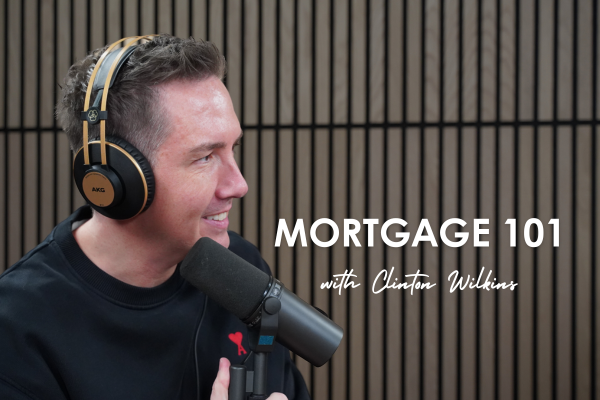Sandi Burns, Chief Credit Officer at Manulife Bank, joins Todd and Clinton to discuss the increasing prevalence of mortgage fraud, the importance of regulatory compliance and evolving landscape of mortgage fraud.

Mortgage 101 – New Budget Updates and Mortgage Incentives
Clinton Wilkins and Todd Veinotte are back this Spring to discuss the latest budget updates, including changes in mortgages and housing incentives. Plus, a debate between Beyonce and Dolly Parton country renditions and how the new housing incentives for new builds may expand the construction industry here in Nova Scotia!
Todd Veinotte
All right, it’s Mortgage 101, your guide to homeownership with myself Todd Veinotte and you, Clinton Wilkins!
Clinton Wilkins
Well, thanks for having me, Todd.
Todd Veinotte
No problem. A little bit of a Beyonce, country style. Why do you feel that people need to hear Beyonce doing a country song?
Clinton Wilkins
I think it is a crowd pleaser, personally. Are you pleased by hearing that it kind of got me excited.
Todd Veinotte
I liked Jolene, but I liked the original, which was Dolly Parton. Exactly. So I would I personally, would have gone with the original because I’m a little old school and traditional.
Clinton Wilkins
Here, I’ll do you a favor. We’ll play Jolene by Dolly Parton later in the show, how about that? That means our listeners really are going to have to stay tuned.
Todd Veinotte
Is that your Executive Decision?
Clinton Wilkins
Sure, let’s go.
Todd Veinotte
Okay. So we’ll end the show with Dolly Parton. And people can tell us which one they prefer the most. Which do you think?
Clinton Wilkins
You know what? I think it might be a mixed bag out there. I think it’s probably Dolly Parton. You know I’m kind of biased to Beyonce.
Todd Veinotte
Yeah no, I must say it’s not bad, I haven’t heard the whole album. But, the tunes that I have heard are okay. And when you hear Beyonce country doesn’t really compute. But, she’s done a pretty good job, I’d have to say.
Clinton Wilkins
I think so.
Todd Veinotte
And the charts would indicate she’s done very well also, which really is all that matters.
Clinton Wilkins
You know, whatever she touches turns to gold, and maybe something like everything the federal government touches turns to gold, or maybe it doesn’t. I guess we’re going to talk about a lot of budgetary items this episode. I think, obviously, anybody who’s curious to know what happened in the budget here in Canada, obviously it was released here yesterday.
Todd Veinotte
Yeah. Well, there’s some pretty big news leading up to the budget, though it’s not as though it’s a big surprise, right? We knew there’s gonna be a lot of hype.
Clinton Wilkins
They love their little nuggets that are dropped along the trail on the way to Budget Day. And certainly a lot to do with housing and the mortgage industry. I can tell you, I’ve been very busy giving my opinion and my two cents worth on what was announced and how it’s going to impact Canadians and obviously borrowers here in this area. Obviously, that’s what we care about the most.
Todd Veinotte
What were some of your biggest takeaways, on the budget stuff pertaining to mortgages? What really grabbed your attention? Kind of itemize it I guess.
Clinton Wilkins
Okay. You know, really overarching, I think the biggest motivation here with this budget is to create more housing for Canadians. We’ve been talking about this for a long, long time. We need more housing starts. And we need all types of housing, we need more of that. So the government was very motivated to get millions of more homes going. And part of that is going to incentivize builders to build, you know, the provinces to work with the federal government, and the municipalities to work with the provinces to get more of the shovels in the ground. So I think that’s great news. That being said, there have been some very significant changes for first time homebuyers. And I think this is something that we’re obviously going to dive deep into today. One of the things is a 30 year amortization, for first time homebuyers buying a newly constructed property. Okay.
Todd Veinotte
That’s just for new, is it?
Clinton Wilkins
That’s for newly constructed, that’s right. Yep. And the homebuyers plan, which is very popular, which the RRSP program was $35,000, now will be $60,000, each individual can withdraw from the RRSP, tax free. The big caveat here is, historically, they had two years before they had to start paying the money back and maybe 15 years total, to, you know, put the money back in their RRSP without being taxed. Now there’s going to be a five year grace period, still with that 15 year runway, but five years with no payments required to build to put those funds back in. So you know, certainly some major changes. It basically equates to $6,000, a year borrower would need to put back in their RRSP, which would be, you know, a total of $500 a month. The one thing we need to remember is, you’re boring this money from yourself. So you’re not going to make anything, you’re not going to save any taxes by putting this money back in. And you’re not going to make any return on your investment while you don’t have the money in there. But, it is a great way to come up with your down payment and reduce your total borrowing cost. You know, at some point you’re gonna have to put in $500 a month on average back in, especially if that five year period.
Todd Veinotte
Okay, in your opinion, not percentages, but is there going to be a lot of uptick on this? Do you think there’s a lot of people out there with that extra money in their RRSPs that could dig into this?
Clinton Wilkins
Yes!
Todd Veinotte
Why do you say that?
Clinton Wilkins
I can tell you a lot of borrowers that that we see all the time. You know, the very first thing that they want to do if they’re first time homebuyer is take that 35,000 out of the RRSP. That’s really the one of the only times that people can borrow from their RRSP tax free. And many of the borrowers that we see, they have more than 35,000 in their RRSP. And I can tell you specifically in bigger marketplaces, I’m not just saying in Halifax, but in Ontario and BC, the amount of downpayment that people need, significantly more than $35,000 in many cases. So, you know, I think it’s a good move. And I think for those borrowers that have been really good at saving, it’s a great way for them to, you know, leverage that investment, and get them, you know, into the housing market. So that’s one of the things honestly, I’m the most excited about. I think I’m more excited about the RRSP program, than I am about the 30 year amortization. But my one caveat is builders are listening. And I think the federal government is just going to be really on the side of builders. I think they’re going to really help build on Canada lands properties all over the country. I really think that there’s going to be a lot of incentives coming down the pipeline for builders to get these home-starts going. And it’s all types like apartments, condos, townhomes, single family homes, duplexes, everything, I think there’s going to be construction. And I think there’s gonna be a lot more motivation to build homes at a lower cost, specifically, even for first time homebuyers to buy, because it’s gonna get them into that marketplace. Like we need, like 3, 4 million homes over the next very short period of time. And I think that the amount of homes that really the government’s projected that they want to have built is about double what the natural amount of homes that would normally be built is. So there’s obviously gonna need to be some changes, we’re gonna need a lot of skilled labor.
Todd Veinotte
I was going to ask you about the Human Resources involved.
Clinton Wilkins
The Human Resources piece, I think is going to be huge. And I think and hope that the government will work with community colleges across the country to get more people into these skilled trades. And I also hope, with our immigration track, that we start bringing in more of the skilled trade workers. We need plumbers, we need electricians, we need carpenters, we need anyone that will really like swing a hammer, because I think that’s one of the biggest challenges. You know, to get this construction done, the challenge is we don’t have enough people that are skilled, or enough people that really want to work in the trades to do this construction.
Todd Veinotte
Do we have enough companies when it comes to all of this? Talking about companies and capital, all that stuff? Because human resources is one thing, but you need to have that component to it as well. So do you feel that that’s in place?
Clinton Wilkins
I can see what’s going to happen, potentially, is the federal government will probably work with the Canadian Mortgage Housing Corporation, their Crown Corp. They could be a mortgage lender. The federal government could also work with the banks to do some loan guarantees, like they’ve done so many unique things over the last couple of years. Even with COVID they’ve done things to securitize funds, work with banks, etc., You know, there’s a lot of ways to get capital flowing effectively, in a cost effective way. And I think it’s just the tip of the iceberg, I think we’re gonna see a lot more programs come out of this. And I’m really here for it. You know, I’m here for housing! You know, we’re in the housing industry, that’s really what our show is about Todd. Here at Mortgage 101, we talk about housing, we talk about mortgage lending, we talk about real estate, we talk about other things that are, you know, involved with it. But, that’s really what it comes down to. Everyone needs a safe, secure, affordable place for them to lay their head every night, and it doesn’t necessarily need to be a single family home.
Todd Veinotte
I was gonna ask you about that. The type of housing that’s being built, we’re talking about, not prefab, that type of thing. What are your thoughts on on utilizing prefab and all of that?
Clinton Wilkins
I’m here for a prefab if it’s on a foundation. What I’m not here for, and I’ve said it here on our show, I’m not a big fan of mobile homes, in the traditional sense, that are not on a foundation. Typically, that is a depreciating asset. Right now it’s appreciated because everyone needs housing. And you know, they’ve gone up. But those type of homes, in terms of like what we consider a trailer, they don’t last forever and they do have problems. I think for a prefab, I’m totally onside with it. I’m mostly talking about these ones that are built into pieces. They come on a trailer of some sort and are put on a foundation. I think that’s a great way to get houses done very quickly and efficiently. I think prefabs kind of had a bad rep. But they’re certainly, even locally here in Nova Scotia and New Brunswick, some great companies that are doing prefabs and that’s certainly something that is very easy to get a mortgage on. Typically we would do that as a turnkey, a single advance. And we see those type of homes certainly being a great way to balance out the cost and also be delivered quicker than a normal stick build could be in a custom home. You know, the federal government is going to work with contractors and developers. I hope that there’s just going to be like some standard building plans that we know can be done very efficiently, quickly. And everyone’s going to be involved; from mortgage lending to suppliers, to contractors, the government, the municipalities, everybody’s going to be involved with really working together, I think over the next 10 years to make this happen.
Yeah and of course, there’s so much to get to. I do want to drill down more into the 30 year mortgage and what that looks like and who can utilize that. So we can talk about that, and what else you got on your mind?
We’re certainly gonna talk about real estate and I mean, it’s spring! Spring is such an important time in real estate and we’re gonna get to that for sure.
Todd Veinotte
Okay, Mortgage 101, yourr guide to homeownership. We’ll be right back!

